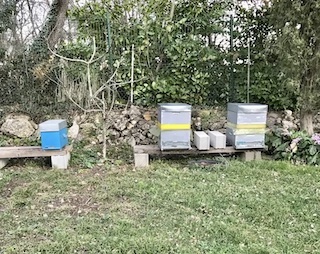First split of 2023

After a period of dry but cold weather the beekeeper is usually in his most worried state of the year. Expanding colonies after the winter solstice and the first blossoms of Mimosa and nut trees encourage the queen to lay and expand the colony for another year. A cold snap may still happen, which can cause lack of honey for the expanding colony to feed on.
This morning, a nice warm and sunny day with a temperature of 25.5 deg C prompted the beekeeper to take a look. He found both colonies ( the grey ones to the right in the photo) to be thriving, both filling the bottom box, capped brood on 5 frames, and most importantly drone cells.
The beekeeper hurried to get his special magnifying glasses to hunt for a few frames with less than three day old eggs. Having found some in each hive he takes one of these frames from each hive and a handful of bees and places them in each side of the partitions of the blue Nucleus hive box, along with a couple of frames with honey on them. The blue Nuc is partitioned already with three frames each side and two entrances. The “beek” closed the hives up and made a tactical withdrawal as it has been hot work and as it was midday he had developed a thirst as well and two new colonies. There was a small problem, 4 of an estimated 60,000 bees saw the withdrawal and followed. The Beek likes to think they followed out of love but reality soon kicks in.
The worker bees will choose an egg and feed it with Royal Jelly and expand the cell to fit the larger body of a queen. If all goes well a new virgin queen will emerge after 14 days and soon after make her “nuptual” flight. She will return to the hive and start laying eggs, for the rest of her life.
The Beek will then have created two new colonies.
In a matter of weeks the colony will need to be put into a larger hive box.
This beekeeper will be carrying out this process about 10 more times, over the next month or two until he has enough colonies for his purposes.
Leave a Reply